 Abstract: The article is about different religions in Tuva in different periods of time — pre-Soviet, Soviet and post-Soviet. The main focus is the contemporary confessional situation in the Republic. Traditional and non-traditional beliefs are studied. This article is based, in particularly, on materials gathered during field-work which was conducted by the author in Tuva in the 2000–2010s.
Abstract: The article is about different religions in Tuva in different periods of time — pre-Soviet, Soviet and post-Soviet. The main focus is the contemporary confessional situation in the Republic. Traditional and non-traditional beliefs are studied. This article is based, in particularly, on materials gathered during field-work which was conducted by the author in Tuva in the 2000–2010s.
Keywords: Siberia, Tuva, Tibet, shamanism, neoshamanism, Buddhism, non-traditional beliefs, confessional situation, protestant communities, the South Korean church, Jehovah Witnesses, missionaries, confessional identity.
Старые и новые религии в Туве
Аннотация: Статья посвящена различным религиям в Туве в разные периоды – досоветский, советский и постсоветский. Основное внимание уделяется современной конфессиональной ситуации в республике. Исследуются традиционные и не традиционные верования. Статья основана на материалах, собранных автором во время полевых исследований в Туве в 2000-е годы.
Ключевые слова: Сибирь, Тува, Тибет, шаманизм, неошаманизм, буддизм, нетрадиционные конфессии, конфессиональная ситуация, протестантские общины, южнокорейская церковь, Свидетели Иеговы, миссионеры, конфессиональная идентичность.
Introduction
The Republic of Tuva is situated in the centre of the Asian continent, on the Russian Federation's border with Mongolia. According to the 2002 census, there are 244,000 ethnic Tuvans live in the Republic. This is a significant majority (around 70%) of the population, unlike in most ethnic-based Republics in the Federation, where Slavic population dominates over the titular nation. The Tuvan people have both Turkic and Mongolian roots, though their language is predominantly Turkic.
Until the twentieth century, the majority of Tuvans lived as nomadic livestock herders. Their official religion is Buddhism, while they also have a traditional belief in Shamanism. Until the middle of the ninth century AD, what is the present-day Tuva was a part of the Turkic and Uighur khanates. It was conquered at the beginning of the thirteenth century by the Mongols and again in the eighteenth century by the Manchurians. After the collapse of the Manchu Qing Empire in 1911, Tuva — at that time called in Russian the Uryankhai krai — became a Russian protectorate. In 1921, the People's Republic of Tannu-Tuva was formed, which was effectively a Soviet satellite state. In October 1944, Tuva became part of the Soviet Union. After the collapse of the USSR in 1991 Tuva remained in the Russian Federation, as the Republic of Tuva (Mongush, 2006: 275).
The Historical Background
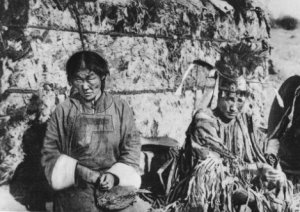 The original religion of the Tuvans was Shamanism. The second major religion of them, Buddhism, was a later (thirteenth century) arrival; it never supplanted Shamanism, but alongside Shamanism was declared one of the two state religions in the eighteenth century. After the overthrow of the Manchurian dynasty in China in 1911 Tuva became a protectorate of the Russian Empire. The Russian authorities did not interfere in the religious life of the region or challenge the authority of the religious leaders, and during the time of the Russian protectorate new Buddhist monastic centers were established.
The original religion of the Tuvans was Shamanism. The second major religion of them, Buddhism, was a later (thirteenth century) arrival; it never supplanted Shamanism, but alongside Shamanism was declared one of the two state religions in the eighteenth century. After the overthrow of the Manchurian dynasty in China in 1911 Tuva became a protectorate of the Russian Empire. The Russian authorities did not interfere in the religious life of the region or challenge the authority of the religious leaders, and during the time of the Russian protectorate new Buddhist monastic centers were established.
In 1921 the Tuvan People`s Republic was proclaimed, in a union with Soviet Russia. Its constitution guaranteed the right of citizens to profess any religion of their choice. Soviet influence was gradually expanded in the republic; but in the early years it took a mild form, partly because of the powerful influence of China in the region.
From 1921 to 1928 the Tuvan government actually took Buddhism under its protection. The Soviet authorities were alarmed, and they had to interfere into this process. Many young Tuvans were taken to Moscow for special education and on their return they took over control of the people`s religious life.
In 1929 an antireligious policy was put in place. However, religious adherence was strong. There were at least 28 monasteries, and out of a total population of 60.000, 4800 were lamas. The 1931 census revealed that there were 725 shamans in Tuva. Antireligious excesses on the part of the government threatened to lead to the alienation of the population and by 1933 the authorities were adopting a more moderate approach: religious beliefs were, for example, proclaimed to be no longer an obstacle to party membership. Systematic antireligious persecution, with the aim of eradicating all religion in the republic, nevertheless began in earnest in 1936. The property of religious institutions was nationalized and clergy were deprived of all political and property rights. By 1937 there were only 5 monasteries and 67 lamas left in Tuva.
In October 1944 Tuva was finally annexed to the Soviet Union as an autonomous oblast of the Russian Federation. In1961 it became the Tuvan Autonomous Republic. At the time of collectivization, which took place much later in Tuva than elsewhere in the USSR, from 1949 to 1954, lamas were still offering resistance, and were even attempting to regenerate Buddhist life. Some surviving lamas met to conduct services of prayer. These unofficial gatherings became known as "praying yurts”. They were led by the most authoritative and educated lama Kenden Khomushku. In early 1950s he moved to the Ivolginsk Datsan in Buryatia and from there continued to lead the Tuvan Buddhists.
Lamas and shamans alike suffered harsh treatment as enemies of the people. Nevertheless, both religions refused to die out completely, and perhaps even reinforced each other`s survival. About 100 lamas were still surviving in 1960. In that year the Tuvan authorities organized a gathering of lamas at which they were forced to adopt a resolution to put a stop to all religious activity. Kenden Khomushku was forbidden to enter Tuva. Nevertheless some lamas continued their religious activity underground and Kenden Khomushku sometimes visited the country illegally.
The traditional religions thus survived communism in Tuva better than most religions elsewhere in the Soviet Union and religious traditions remained a living element in Tuvan national consciousness.
In Tuva today one of the central conflicts in the development of religiosity in the post-soviet Russian Federation is revealed perhaps more sharply than anywhere else. This is the conflict between "restoration” and "innovation”, between those who want to restore what they see as the traditional religious structures of the country and those who welcome the range of alternatives now on offer. Since Tuva came so late into the Soviet Union and antireligious measures were muted at first, the population`s memory of how things used to be is livelier than in most other parts of the Russian Federation (Walters, 2001: 25).
Revival of Buddhism
The government of Tuva today officially recognizes three religions: Buddhism and Shamanism for the Tuvans and Orthodoxy for the Russians. In 1995 Tuva was 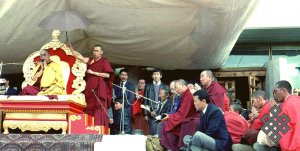 one the first regions of the Russian Federation to adopt its own law on religion, drawn up in consultation with representatives of the Buddhists, shamans and Orthodox. The law confirmed recognition of these three faiths. It made no provision for any kind of mechanism for state support, but concern for the future of the three faiths prompted the government to adopt a plan for the "Development of traditional religions of the peoples of the Republic of Tuva” in 2000.
one the first regions of the Russian Federation to adopt its own law on religion, drawn up in consultation with representatives of the Buddhists, shamans and Orthodox. The law confirmed recognition of these three faiths. It made no provision for any kind of mechanism for state support, but concern for the future of the three faiths prompted the government to adopt a plan for the "Development of traditional religions of the peoples of the Republic of Tuva” in 2000.
Among the Tuvan political elite there is a widespread idea that it is Buddhism that needs to be restored as the ideological basis of Tuvan statehood. Government funding has been forthcoming for the construction of Buddhist temples. The systematic revival of Buddhism was given a boost in 1992 after the first visit of the Dalai-lama to Tuva. At that time an agreement was signed between the government of Tuva and the Tibetan government in exile. In1993 the spiritual representative of the Dalai-lama in Russia and Mongolia, Geshe Jampa Thingley, visited Tuva. Since this time he has been visiting the republic on regular basis. Another popular Tibetan spiritual master is Bogdogegen, who also visits Tuva rather often. Many Tuvan young people get spiritual education in the Tibetan monasteries in South India (Mongush, 2010: 118).
Buddhism as taught and practiced in Tuva, in contrast to Buddhism in Buryatia and Kalmykia, nevertheless remains traditional: its distinctive feature is its faithfulness to the Tibetan Gelug school and its recognition of the undisputed authority of the Dalai-lama. Contacts are practically exclusively with Tibetan Buddhists. Buryat Buddhists, who are active in other parts of Russia, have not so far made any inroads in Tuva. Representatives of other Buddhist traditions, including Ole Nydal, masters of Theravada and followers of Dzen Buddhism, have visited Tuva, but none of them has won any following. There are no contacts with Western Buddhism (Walters, 2001: 27).
Another distinctive feature of Tuvan Buddhism is the result of its centuries-long coexistence with Shamanism. It has adopted some shamanistic traditions: the cult of ovaa (spirit-guardians of a place) and eeren (protectors of the family), for example. In earlier centuries shamans would often take part in Buddhist ceremonies alongside the lamas and in the monastery there used to be a special category of spiritual individuals — the burkhan-kham (lama-shaman). If in the 1920s Tuvan Buddhism took into itself shamanistic traditions and gave them a Buddhist interpretation, now the reverse is happening: the shamans are taking Buddhist rituals and are interpreting them in a shamanistic way (Mongush, 2010: 63-64).
There is widespread feeling in Tuva that Buddhism should be confirmed in its role as the basis for social, political and cultural life, as the consolidating factor in the development of society. Buddhist clergy hope to succeed in imbuing politicians with high moral qualities and the Buddhist values of tolerance, charity and openness. The fact that few Tuvans know much about the essence of their traditional faith does not free them from the responsibility of identifying themselves as Buddhists, which is the most important first step. Fuller religious understanding will come with time, either to today`s Tuvans or to their children.
Activity of neoshamans
Meanwhile, Shamanism is flourishing as vigorously as Buddhism in today`s Tuva — perhaps more so, since its roots proved harder to eradicate in socialist times.  Traditional paganism among the Tuvans had no organized form; it was preserved and passed on as a part of folk culture. Formal pagan organizations are a new phenomenon of the post-Soviet period. Now there is a centralized shamanistic organization in Kyzyl and local branches in various parts of Tuva. They are registered separately, but are all parts of the same phenomenon: coordinating centers for what is a growing mass movement.
Traditional paganism among the Tuvans had no organized form; it was preserved and passed on as a part of folk culture. Formal pagan organizations are a new phenomenon of the post-Soviet period. Now there is a centralized shamanistic organization in Kyzyl and local branches in various parts of Tuva. They are registered separately, but are all parts of the same phenomenon: coordinating centers for what is a growing mass movement.
A significant figure who had genuinely 'shamanic roots' was Oleg Toiduk, who unfortunately died very young, at the end of the 1990s. He was forty-six years old. His story shows how shamanic lineages have survived the Soviet period. Glory and fame came to him suddenly. In his own words, the most important events of his life were as follows:
My parents had twenty-one children. My father Erenchin was a famous shaman. He was a healer: he set broken limbs, replaced dislocations, repositioned the child inside pregnant women, and often officiated at births himself. When I was twelve years old, my father started to teach me the shaman's craft. I resisted for a long time, because I thought it was a relic of the past. But my father was firm and passed me all his knowledge. And it was only when I was mature that I knew there was no way away from the shamanism that my ancestors had practised (Mart-ool, 2002: 29–30).
Toiduk came into possession of the heritage that had been left him. He inherited a series of unique elements, such as the shamanic eerens — patron spirits that could take the form of the tusk of a wild boar, or the claws and nose of a bear. Toiduk also received the kuzungu, or shamanic mirror, and the khuvaanak, a collection of forty-one pebbles gathered from the beds of different rivers and streams. Toiduk also had the dungur, the shamanic drum; the demcheek, or rattle; and the ochur, or symbolic materials. These all are items with connections to attributes of Buddhist cults. With the help of the dungur, Toiduk was able to drive evil spirits out of madmen, and the demcheek and ochur allowed him to heal the sick. He was the only shaman of the modern era who could lick red-hot iron. According to Toiduk himself, this latter ability, which all shamans in the past possessed, not only had a psychological effect on the sick, but was also an effective method of fighting the evil spirits who caused various diseases. Toiduk said that 'when he performed such an action, he received a great amount of new energy' (Ibid: 30–34).
Toiduk was not only a healer, but also a fortune-teller. He usually told fortunes with the aid of the kuzungu. Once he was called on by a woman, who was planning to visit her absent son, and she asked him to 'see' what her road to Moscow would be like. Toiduk gave a categorically negative answer, which caused the lady to change her mind about travelling. Only a couple of days later the lady's mother died, and her brother died in tragic circumstances a week after that. The shaman, foreseeing a series of unfortunate events, had protected the woman from being on the road, far away from her loved ones, at the moment these sad events occurred (Ibid: 31).
Another example of Toiduk's accurate prophecy comes from one who witnessed what happened. As they described it, Toiduk was one of a group of people standing around, talking amongst themselves. Suddenly he turned to the man next to him with the following warning: 'You shouldn't drive a car in the near future. You smell of iron. You might be in a car crash.' To which the man, an excellent driver, replied, 'Impossible, I drive very well.' A week later he was in a car accident along with his whole family. They were all killed.
The story of the shaman Toiduk is typical — his predilection for the shamanic way of life is beyond doubt. Lots of people declare that similar things happen often in modern-day Tuva, as they did in former times as well.
During the 1990s Shamanism in Tuva has benefited from international interest, both from academics who prize this well-preserved ancient faith as an object of study and from enthusiasts seeking a new source of mystical contact with nature in the context of the postmodernist Western culture. In 1993 the first Tuvan-American conference of shamans and professional researchers of Shamanism took place, with participants from America, Canada, Finland as well as Tuvan academics and members of Shaman society "Dungur” (drum). A result of the seminar was a resolution by the government of Tuva, setting up a research center for the study of Shamanism, under M. Kenin-Lonsan, at the Tuvan National Museum (Walters, 2001: 29).
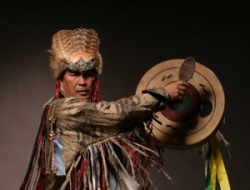 Shamanism today is recognized as one of the three traditional religions of Tuva and has a certain amount of support from the state, although not as much as Buddhism. The government has made land and buildings available for the shamanistic organizations, including two buildings in Kyzyl. A small group of shamans works there for a few months at a time before being replaced by other shamans from the regions. One of these building includes a center attached to the Dungur society for teaching children about Shamanism.
Shamanism today is recognized as one of the three traditional religions of Tuva and has a certain amount of support from the state, although not as much as Buddhism. The government has made land and buildings available for the shamanistic organizations, including two buildings in Kyzyl. A small group of shamans works there for a few months at a time before being replaced by other shamans from the regions. One of these building includes a center attached to the Dungur society for teaching children about Shamanism.
At the moment there are about 200 shamans in Tuva, just a few of them are considered to be real shamans.
Meanwhile researchers justifiably note that one ought not put an equal sign between traditional Shamanism and the contemporary Shamanism, which is being actively revived today. In order to distinguish the one from the other, some propose that the modern version be called "Neoshamanism”. This occurred under the influence of the research of American anthropologist Michael Harner, who introduced the term "base Shamanism”, or "Neoshamanism”. The differences between traditional Shamanism and Neoshamanism are as follows (Mongush, 2010: 124).
First, if in traditional culture Shamanism — was accessible only to those, — who were clearly and obviously chosen by spirits, or to whom this gift was transferred by inheritance, today`s Shamanism has become accessible practically to anyone, who is sincere and accepts the basic conditions of Shamanism.
Second, if in the past a person did not choose — the shamanic path for himself (herself), he (she) was selected for it by spirits (refusal of this gift led to illness), now this path is chosen voluntarily.
Third, if in traditional society shamanic practice occupied a central place in the life of a person, everything else remained on the second and third levels. In the contemporary situation — the person decides himself, what place shamanic practice will take in his life. As a rule, it fits completely with other aspects of life. This is easily seen from the aforementioned example of M. Kenin-Lopsan, who is a Shamanism researcher — a practicing shaman and — a popular Tuvan writer at the same time.
Fourth, if in the past a shaman could work only in his own tribe and his power depended directly on a concrete geographical place, today he can practice independently and does not need to be attached to a specific geographical place or ethnic group.
At the same time, a new tradition has been born on the basis of Neoshamanism —urban Shamanism. Its existence, primarily in the cities, far from the nature and the places of power, is paradoxical for shamanic practices.
Another distinctive feature of Neoshamanism is its incredible openness to the external world, which, in the past, was ignored. This is expressed in the public performance of shamanic rituals and the teaching of the shamanic "craft”. This has led to the appearance, among the Tuvan neoshamans, of representatives of other nations, who as a rule, had no shamanic past. One of the clearest examples of this is the activity of a graduate of the the Moscow University`s Department of Psychology, Vera Sazhina, who practices as a shaman — in Moscow and Tuva, having everywhere her own clients. She has opened a Shaman organization in the Ulug-Khem district of Tuva in memory of her teacher Kh. Khuurak, who was a well-known shaman. V. Sazhina has a good command of Tuvan and she usually performs shamanic rituals in Tuvan. Another example is Moscow psychologist Roman Nesterov, a graduate of the same Department of the Moscow University. He was accepted in the clan of his teacher — S. I. Kanchyyr-ool, and after Kanchyyr-ool`s death in 2007, Nesterov inherited his shamanic attributes (Anayban, Donahoe, Kharitonova, 2008: 177).
It is an interesting phenomenon that Shamanism became tightly connected with throat singing — khoomei. There are many cases today, when one and the same person is simultaneously a throat singer and a shaman. For example, Tuvan performer Nikolai Oorzhak has opened a throat singing training course for everyone who wants to sing in this style. During this course, Nikolai Oorzhak also acquaints his students with the world view of Shamanism and some shamanic ritual practices.
Free choice
Half of Tuvans see themselves as Buddhists, half as shamanists. Sometimes, at the individual level, there is a case of someone abandoning one of these religious traditions of her own free will. The case of Belek-kys Salchak (born 1955, inhabitant of Kyzyl) illustrates this clearly. At the beginning of the 1990s Belek-kys Salchak opened a small private shop in Kyzyl, selling alcoholic drinks. Her business went well, she had a high turnover of stock, her family were materially well 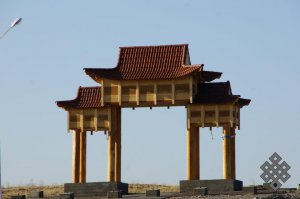 off. But she was in an accident, and could not look after herself for a long time afterwards. She went to a shaman who told her that the cause of her trouble was her neighbour, who had the 'evil eye' and 'a black tongue' — the shaman promised to remove the negative influence on Salchak. However, Belek-kys's health did not improve, and she ruined her relations with her neighbour. Then she turned to a Tibetan lama for help. After he had heard her story and performed a divination with the help of special books, he advised Belek-kys to rid herself of her bad karma — she should stop selling alcoholic drinks to the populace and take up a more healthy business. Belek-kys followed the advice and opened a small cafe, which made her an adequate return. Her health gradually stabilised. According to Salchak's testimony, it was this event which brought her finally into the Buddhist fold. She has had no contact with shamans since then, and advises her relatives to do likewise.
off. But she was in an accident, and could not look after herself for a long time afterwards. She went to a shaman who told her that the cause of her trouble was her neighbour, who had the 'evil eye' and 'a black tongue' — the shaman promised to remove the negative influence on Salchak. However, Belek-kys's health did not improve, and she ruined her relations with her neighbour. Then she turned to a Tibetan lama for help. After he had heard her story and performed a divination with the help of special books, he advised Belek-kys to rid herself of her bad karma — she should stop selling alcoholic drinks to the populace and take up a more healthy business. Belek-kys followed the advice and opened a small cafe, which made her an adequate return. Her health gradually stabilised. According to Salchak's testimony, it was this event which brought her finally into the Buddhist fold. She has had no contact with shamans since then, and advises her relatives to do likewise.
Another example is the case of Valentina Balchii-ool (born 1934, inhabitant of the Barun-Khemchik kozhuun), a teacher by profession. A large sum of money — which she had been saving up to buy her son a car — vanished from this woman's flat. The shaman to whom she turned for help told her that her fellow-villager had stolen the money when he had come to stay with her. The description the shaman gave of the theft was accurate even in its details. Having named the guilty man, the shaman advised Valentina to 'wipe him out,' and described a possible scenario: an unfortunate 'accident,' from which no clues could be traced back to Valentina. Valentina categorically refused to do this, a notion she had never entertained. 'What are things coming to if people finish each other off with the help of a shaman?' she wondered.
Because the ways and means by which shamans and lamas offer help differ widely, there is sometimes friction between them, as well as disagreement and rivalry. The Tibetan lamas, when they came for the first time and started to work in Tuva, were highly astonished to be met by men 'from the White House' (i.e. from government), who asked them to 'deal with' their political rivals. The Tibetans had to spend a long time explaining the Buddhist doctrine of karma, by which any bad action, even if carried out in thought alone, brings a negative result to its instigator.
In a similar situation shamans would not bother themselves with morals, they prefer their own ways of providing help. Therefore, the person to whom one turns in cases of need — the shaman or the lama — is an entirely individual matter and also depends on the nature of one's business. However, this does not affect the equilibrium that exists between the two religions on the sphere of confessional relations, and to talk of a general lack of agreement between the two tendencies has no grounds in fact.
Russian Orthodox and Old Believers
They are present in Tuva, but their numbers are small. The first Orthodox mission in Tuva was organized in 1868. The first Orthodox church in Kyzyl was built in 1911. It was subsequently destroyed, but in 1929, at a time when such a thing would have been impossible in the Soviet Union, it was replaced by a new church, 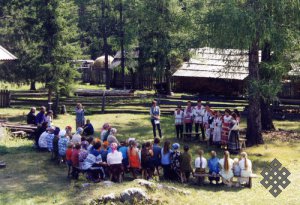 which continued to function throughout the Soviet period. Institutional Christianity was preserved under the Communist regime more effectively in Tuva than in most other places in the USSR.
which continued to function throughout the Soviet period. Institutional Christianity was preserved under the Communist regime more effectively in Tuva than in most other places in the USSR.
Nevertheless, Orthodoxy has always remained of minor significance in Tuva, which is practically the only region of the Russian Federation where Orthodoxy has experienced no revival in the 1990s. The Orthodox in Tuva are confined to two parishes, in Kyzyl and Turan, and five communities. In practice, Orthodox life centers on these parishes, which have several hundred members who attend the regular services on Saturday evenings and Sunday mornings, and up to 1000 who attend services at festivals.
A high proportion of the congregation are young people. The church runs a Sunday school, which is attended by children and adults. Tuvans make up ten per cent of the congregation, they are people who previously had no faith rather than converts from Buddhism or Shamanism. The church does not do missionary work among the Tuvans. There is a children`s Bible in Tuvan and a translation of the Gospel of St.John, but there is no sign of any prospective Tuvan priest yet.
The church runs no monastic communities or organized charitable activity. In spite of this the position of Orthodox church in Tuva is firm and stable.
Old Believers started coming to Tuva at the end of the nineteenth century, escaping from the persecution at the hands of the Russian authorities.
At the time of collectivization and Communist persecution many Old Believer families went into hiding in inaccessible places, while others, men and women, withdrew into the forests to live alone as hermits. There are still many such hermits today, and they enjoy great spiritual authority among the local Old Believers, who often turn to them for advice.
New religions
Despite the quantitative advantage of traditional religious organizations, nontraditional confessions have had a significant effect in the Tuvan world. Among them the religious organizations of Protestant orientation have conducted the largest-scale activity, and have branches not only in large cities, but also in the distant regions of the republic, where predominantly Tuvans live. Consequently, a contingent of believers here is made up of native people. In contrast to the Orthodox and Old Believers, the Protestants see missionary work as a high priority.
According to the degree to which they have become widespread among them the following associations are most influential.
The South Korean Christian church of the Evangelical "Sun bok Ym” faith was organized in May 1995. It is led by a minister from South Korea. Several hundred people, 99% Tuvans and about 70% people of young and middle age regularly attend divine services. In 1997 a new religious community, "Way to the Truth”, created a division in the church. The Tuvan Nationality minister became its leader. Tuvans constitute the overwhelming majority. Both of these organizations are Pentacostalist.
The church is active in charitable work, distributes humanitarian aid from South Korea and assists children`s homes through a special fund. Church members pray for the local authorities and consider themselves patriots. The church sets great store by wealth and health, forbids smoking and alcohol, and has a strict approach to morality. The pastor explains in his sermons that, like the Tuvans, Koreans were also Buddhist once, and lived in poverty, but that now they have accepted Christianity they are starting to flourish. Church members are travelling around Tuva opening branches of church in the districts; in these churches services are conducted in the Tuvan language only. The church`s missionaries see one of their basic tasks as working with young people and the relatives of believers.
The religious community of Jehovah`s Witnesses was officially registered in 1993. It is a fairly large association and is also led by a Tuvan.
Baptism is a crucial moment for the followers of Jehovah`s Witnesses. It is not performed immediately, but after the passing of some time, when the new follower shows himself (herself) to be an active servant. There are over 100 Jehovah`s Witnesses in Tuva; more than half of them are Tuvans.
The Missionary society "The Christian” was registered in 1993. It belongs to the Russian Union of Christians of Evangelical faith and is also a fairly ramified and influential religious organization. This organization has a whole network of "daughterly” associations in practically all districts of the Republic, even in places such as Tes-Khem and Erzin, where the positions of Buddhism are traditionally very strong.
There are about 20 associated churches and groups in various places in Tuva and the congregations of all of them are almost entirely Tuvans. About 10 % have high education. For the first years the Tuvans watched the church growing, but then there was a breakthrough: the church has succeeded in breaking down the stereotype, whereby Christianity is seen as the Russian religion. The congregations have started supporting people who know the Tuvan language and traditions well, and services are being conducted in Tuvan. On one occasion there was trouble with the authorities, when a converted female shaman started destroying sacred sites, upsetting the local people.
Analyzing the activity of this society, researchers note the well-established system of instruction for its followers (they are regularly carried out at conferences, in schools and other forms of study), and also the generous financing, which helps to rent accommodations and give material support to followers, as well as to secure necessary literature and the payment of services for translations of publications into the Tuvan language. The Bible has already been translated.
However, the list of confessions active in Tuva is not limited to the orientations mentioned above, since there are a number of other unregistered religious organizations. There is a Moslem community among them, for example, which brings together mainly representatives of the Tatar diaspora. There is also a small group of Krishna followers. They all exhibit varying degrees of activity.
In contrast to other regions of Russia, none of the confessional orientations represented in the Republic, has political ambitions. The experience of holding elections at the federal and regional levels has shown that local politicians did not use the religious factor in Tuva. Also, no facts have been noted indicating that religion led to interethnic tension and conflicts. The increase of religious consciousness, observed among the recognized nationalities of the Russian Federation, is connected, above all, with the processes of national and cultural revival, which, in turn, serves as an indicator of ethnic unification.
Conclusion
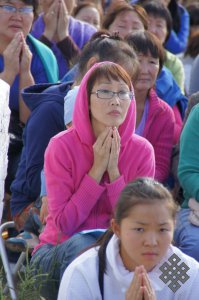 To the question on the propagation of new religions in Tuva, significant part of the population categorically answered that "only traditional religions should exist” — 42,38%; 14,23% consider that "any religions should be allowed to spread”, and 17,23% answered "any religion can spread with traditional priority”. In this case the preoccupation apropos of the retention of traditional culture nevertheless makes it possible for the majority of those interrogated to preserve sufficiently tolerant position with respect to other confessions. So, more than half (54,71%) of the people answered that "it does not matter, to what religion a person belongs, if he (she) observes moral commandments” (Mongush, 2010: 164-165).
To the question on the propagation of new religions in Tuva, significant part of the population categorically answered that "only traditional religions should exist” — 42,38%; 14,23% consider that "any religions should be allowed to spread”, and 17,23% answered "any religion can spread with traditional priority”. In this case the preoccupation apropos of the retention of traditional culture nevertheless makes it possible for the majority of those interrogated to preserve sufficiently tolerant position with respect to other confessions. So, more than half (54,71%) of the people answered that "it does not matter, to what religion a person belongs, if he (she) observes moral commandments” (Mongush, 2010: 164-165).
Relations between the various confessions in Tuva are generally good. Lamas and shamans, as well as representatives of Tuvan intelligentsia are, however, alarmed by the rapid proliferation of Protestant churches and sectarians. They deplore incidents such as the burning of portraits of the Dalai-lama. They believe that the activities of the more aggressive denominations should be limited by legislation. They are particularly critical of American and Western missionaries, who, they say, often recruit followers not by preaching, but by offering material goods.
The government of Tuva follows a policy of religious toleration, and there have been very few instances where the secular authorities have intervened to curb the activities of religious enthusiasts.
Thus, the contemporary religious structure in the republic of Tuva is a result of a historically prolonged and complex process. Its complexity is determined by poly-confessionality, which is characterized by two tendencies: revival and development of traditional religious beliefs and the growing influence of new, predominantly Protestant religious directions, that were not previously widespread in the Republic.
Reference
Anayban, Z., Donahoe, B., Kharitonova, V. (2008) Etnicheskie protsessy v sovremennoi Respublike Tuva // Tyurkskie narody (Ethnic Processes in Modern Republic of Tuva // Turkic peoples). Moscow. P.153–204.
Mart-ool, S. (2002) Personalii tuvinskih shamanov (shaman Toiduk-hkam) i problema sozdania biographicheskoi bazy dannyh sibirskih shamanov (Personas of Tuvan shamans (Toiduk-kham) and problem of creation of bibliographic data base of Sibirian shamans) // Seres Lectionum Studiorumque Instituti Asiae Interioris. Vol. 1. Budapest. P.27–35.
Mongush, M. (2006) Modern Tuvan Identity // Inner Asia. No. 8. Cambridge. P. 275–296.
Mongush, M. (2010) Odin narod: tri sudby. Tuvintsy Rossii, Mongolii i Kitaya v sravnitelnom kontekste (One People, Three Fates. Tuvans of Russia, Mongolia and China in Comparative Perspective). Osaka.
Walters, Ph. (2001) Religion in Tuva: Restoration or Innovation // Religion, State and Society. Vol. 29. No. 1. P.23–38.
Скачать файл статьи

